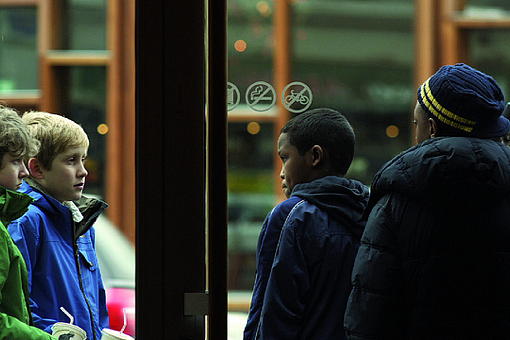By Ryan Mason · November 11, 2011

After the credits rolled for Ruben Östlund’s Play, I nearly expected Ashton Kutcher to bust into the theater with cameras. No way was this a real audience. Clearly I, along with some of my fellow moviegoers, were being Punk’d. Or, even better, unknowing participants in an elaborate sociological experiment to see how adults react to bully-like behavior while watching a movie about kids dealing with bullies. I truly hope it’s the latter because those scientists must’ve been thrilled to see how quickly we non-children humans devolved into near mayhem over things that could’ve been handled with the simplest of communication methods.
Let me explain, and in doing so, you’ll see why it’s relevant to the excellent Swedish film, Play.
From the moment the reels rolled for Östlund’s superb drama, the audience fun began. First, there was the Swedish couple two seats over from me who continued on with their pre-roll chatter long after the title credits were over. At some point, an Asian guy a few rows in front of me had to be held back by his friend from leaping over the seat and starting a fight with someone who evidently had been doing something to irritate him. And then there was the woman directly in front of me who nursed a bag of popcorn the entire film, electing to noisily crumple up the bag every few minutes (perhaps to keep it warm?). It’s amazing I was able to even review the film after all is said and done considering the chaos erupting in the theater.
But, it’s a testament to Play that I can safely say that Östlund’s third feature is fantastic. The tension Östlund conveys using a predominantly static camera displays a total mastery over character and dramatic conflict. Most shots go on for minutes at a time without a cut, with rarely even any camera movement. And Östlund tends to use a long lens, which compresses the space, making it hard to tell how far away things are despite also being distanced from the action. It creates an odd and powerful feeling that we’re bystanders to these events. And while I’m sure many average American moviegoers would find this all excruciatingly boring at face value, it’s surprisingly riveting.
Östlund tells a tale about a group of five teenaged boys who scam other kids out of their cell phones. We see them harassing a couple of boys in the opening scene, where we learn their scheme, and then Östlund brings in the main characters: John, Sebastian, and Alex, three young teenagers who go downtown to the mall to hang out when they run into the five hoodlums and naively go along with their fraud to prove that they haven’t stolen anyone’s phone. They then end up on an odyssey heading out into the countryside, everyone wondering just what sinister ends these punk kids have planned for them.
Play is all about bullying, emotional torment, and the trials and tribulations of adolescence. But it’s also about how bullies are human, too. And that even knowing you’re right doesn’t automatically make your actions right. Östlund balances all of this tension with perfectly timed moments of levity, where the film gets truly funny.
So, as the credits finished scrolling by and the house lights came back on, the Asian guy who had nearly gotten out of his seat to fight was once again turned around, arguing heatedly with the guy behind him. Apparently the other guy had thrown something at him. And so had another couple from farther up in the theater. Their collective reason for said attack? The Asian guy had been on his phone for much of the movie, annoying the hell out of everyone else in his eyeline. Leave it to the screening of a movie whose entire plot stems from an iPhone that it would enjoy such hoopla in the theater revolving around, what else, an iPhone.
I doubt that Östlund had ever anticipated the audience watching Play to burst into a real-life, real-time reimagining of it. But, I have to admit, I think it added to the overall experience of the film. Talk about a reflection of society. Östlund’s film was so prescient, it was reflecting on this very moment. Regardless, even if you’re unfortunate enough to see this with a perfectly behaved group of fellow moviegoers, Play is a true delight by a filmmaker absolutely confident in his abilities to use cinematic tools to tell a captivating story.